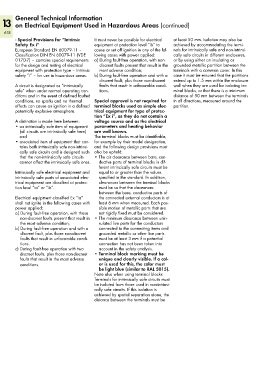Page 620 - Wago_PCB_TerminalBlocksConnectors_Volume2_2015_US
P. 620
General Technical Information
13 on Electrical Equipment Used in Hazardous Areas (continued)
618
- Special Provisions for “Intrinsic It must never be possible for electrical at least 50 mm. Isolation may also be
Safety Ex i” equipment at protection level “ib” to achieved by accommodating the termi-
European Standard EN 60079-11 – cause or set off ignition in any of the fol- nals for intrinsically safe and non-intrinsi-
Classification DIN EN 60079-11 (VDE lowing cases with power applied: cally safe circuits in different enclosures,
0170-7) – contains special requirements a) During fault-free operation, with non- or by using either an insulating or
for the design and testing of electrical discreet faults present that result in the grounded metallic partition between the
equipment with protection type – Intrinsic most adverse condition; terminals with a common cover. In this
safety “i” – for use in hazardous areas. b) During fault-free operation and with a case it must be ensured that the partitions
discreet fault, plus those non-discreet extend up to 1.5 mm within the enclosure
A circuit is designated as “intrinsically faults that result in unfavorable condi- wall when they are used for isolating ter-
safe” when under normal operating con- tions. minal blocks, or that there is a minimum
ditions and in the event of defined faulted distance of 50 mm between the terminals
conditions, no sparks and no thermal Special approval is not required for in all directions, measured around the
effects can cause an ignition in a defined terminal blocks used as simple elec- partition.
potentially explosive atmosphere. trical equipment for type of protec-
tion “Ex i”, as they do not contain a
A distinction is made here between: voltage source and as the electrical
• an intrinsically safe item of equipment parameters and heating behavior
(all circuits are intrinsically safe here) are well known.
and The terminal blocks must be identifiable,
• associated item of equipment that con- for example by their model designation,
tains both intrinsically safe non-intrinsi- and the following design provisions must
cally safe circuits and is designed such also be upheld:
that the non-intrinsically safe circuits • The air clearance between bare, con-
cannot affect the intrinsically safe ones. ductive parts of terminal blocks in dif-
ferent intrincically safe circuits must be
Intrinsically safe electrical equipment and equal to or greater than the values
intrinsically safe parts of associated elec- specified in the standard. In addition,
trical equipment are classified at protec- clearances between the terminal blocks
tion level “ia” or “ib”. must be so that the clearances
between the bare, conductive parts of
Electrical equipment classified Ex “ia” the connected external conductors is at
shall not ignite in the following cases with least 6 mm when measured. Each pos-
power applied: sible motion of metallic parts that are
a) During fault-free operation, with those not rigidly fixed must be considered.
non-discreet faults present that result in • The minimum clearance between unin-
the most adverse condition; sulated live parts for the conductors
b) During fault-free operation and with a connected to the connecting items and
discreet fault, plus those non-discreet grounded metallic or other live parts
faults that result in unfavorable condi- must be at least 3 mm if a potential
tions. connection has not been taken into
c) During fault-free operation with two account in the safety analysis.
discreet faults, plus those non-discreet • Terminal block marking must be
faults that result in the most adverse unique and clearly visible. If a col-
conditions. or is used for this, the color must
be light blue (similar to RAL 5015).
Note also when using terminal blocks:
Terminals for intrinsically safe circuits must
be isolated from those used in non-intrinsi-
cally safe circuits. If this isolation is
achieved by spatial separation alone, the
distance between the terminals must be

